Drama, Pelicans and Tombstones: London III
Monday saw me visiting another bunch of dead Victorians - or perhaps more accurately dead Georgians who made it into Victoria's reign and some additional Victorians - at Kensal Green Cemetery, more on that below the cut complete with photos; and before you ask, that is the end of my morbid cemetery exploration during this particular London trip.
On the other hand, hitting the London theatres continues; on Monday I also met up with
kangeiko and saw A Taste of Honey by Shelagh Delaney at the National. Neither of us knew anything about the play other than the name of the author, the title and that it was now considered a modern classic. My main reason for wanting to see it was that Lesley Sharpe plays one of the two leading roles. Now that I've watched it, though, I am in awe that a play like this could be created and staged in 1958, by a female author, and so utterly unlike the simultanous plays of John Osborne & Co. In fact, depressingly it still stands out compared with much of today's theatre, tv and cinema output, many decades later. First of all, the main focus is on a complex mother-daughter relationship. Secondly, the daughter, Jo, has an affair with a black sailor, Jimmie, and later has a gay friend, Geoffrey, who moves in with her. The mother, Helen, had Jo when she was young and the two at times act more like bickering sisters than like mother and daughter, with Jo as the responsible one; Helen is also in and out of relationships which more or less provide her income. Inevitably, Jo, too, gets pregnant. And yet: Nobody committs suicide or beats each other up or gets murdered. No one is slut shamed. And not because anyone is living in an idyll or life is kind. The program had a line about the characters being "different types of survivors in a world that doesn't throw anyone lifebelts", and that's true, and yet it is not a cynical play. The characters and their relationships come across as three dimensional and true, and no one feels like a vehicle for the author's rant on issue X. Now I'm all the more frustrated Shelagh Delaney didn't go on to write many more plays (though she did write one more play and some radio and tv scripts, as a quick googling tells me). What a talent! Yes, some writers have only one perfect work in them - see also Harper Lee - but those are the exception; most, given the opportunity, can do more.
As for the production, I thought both Kate O'Flynn as Jo - who is on stage in most scenes and so really needs to be good - and Lesley Sharpe as Helen were fabulous, and so was their supporting cast. The staging and costumes went for the time the play was written in and set, i.e. late 50s, and yet it didn't feel "period" in the sense of feeling distanced; it never played into nostalgia, being too sharp and witty for that. In conclusion: if you're in London for the next two months, try and catch it!
Yesterday was no theatre day because I was invited to a wonderful friend of mine for dinner, a lovely old lady who is one of the most amazing people I've known, and who'll be 90 next year. She's originally from Munich where her father was a very respected lawyer. You may have seen his photo, because when the Third Reich arrived, her father made the mistake believing in justice and complained to the police about harrasment. In response, they made him run through Munich in his underwear with a sign around his neck saying "I am a Jewish pig and will never complain to the police again". (Last year at the anniversary of the so-called "Reichskristallnacht" the photo got reprinted in a lot of Munich-based media again.) Anyway, Bea's parents then got her out of the country via the Kindertransport to England, hence her ending up here. I met her over a decade ago and we've been in contact ever since; she's so full of life and charming and optimistic that you're moved and humbled by her very presence if it wasn't that she's far too animated and drawing response not to enjoy oneself just for the good company.
(I cried once anyway, years ago, because sometimes the awful horror of it all overwhelms you anew.)
Anyway, yesterday evening I visited her and her family, and we had a great evening. It included an anecdote about an encounter with the royals apropos a Holocaust museum/exhibition opening here in London, where Bea and other surviving children who came to England through the Kindertransport had been invited and were presented to the Queen and Prince Philipp. Said exhibition included a model of Auschwitz, with the huts all in white, according to Bea. Says Philipp, gesturing towards the Auschwitz model: "And where do you live now? Not there anymore, right?"
.....
Tuesday was good for hanging out with friends, though; lunch I spent with
kathyh at a pub which was an amazing relic of the turn of the (19th into 20th) century full of art deco. Originally we met at the Modern Tate and were planning to have lunch there, but it was too crowded, it being half term in Britain this week, which I hadn't known but which explained all the children I encountered. Generally speaking, I prefer the Tate Britain because of the Williams Turner and Blake represented there, but I did want to see the Richard Hamilton exhibition, which included his series of pictures called "Swingeing London" (sic, it's a pun) using the photo of Robert Fraser and Mick Jagger handcuffed to each other when arrested during the 1967 drug bust, and his design for the Beatles' White Album. (The cover, obviously, is just white, but the exhibition also had the original for the inside poster that came with the LP and was based on a collage of photographs culled from their archives. Today in the age of the cd (well, the age of Itunes, I guess,now), you can't make out individual photos,far too tiny, but in the big A3 size original where all the photos are in their original size, too, you can, and my inner Beatles obsessive was not a bit embarrassed to be able to identify many of them. (Both the original cover design and the original inside poster design were said to be on loan from a "private collection", which I guess means Paul McCartney.)
And now for the graves of Victorian writers (guess who still gets flowers and who doesn't?) and the sisters, wives and best buddies of Mr. Mad, Bad and Dangerous To Know himself, Lord Byron (those would be the Georgians I mentioned earlier. And because they are adorable, some of Sunday morning's pelicans, whose ancestors supposedly came to St. James Park with the Restoration and Charles II.
Jane Francesca, aka "Speranza" Wilde - "mother of Oscar, William and Isola", as it says on the tombstone - was a fervent Irish nationalist, a collector of fairy tales and early feminist; her salons in Dublin and later in London were famous (and open to newbies; George Bernard Shaw never forgot she was nice to him, invited and introduced him when he first came to London). She adored her oldest son, and died during his time in prison. Her younger son, Willie, is buried with her, as is Willie's wife; Oscar, of course, is buried at Pere Lachaise in Paris. This is her grave at Kensal Green:
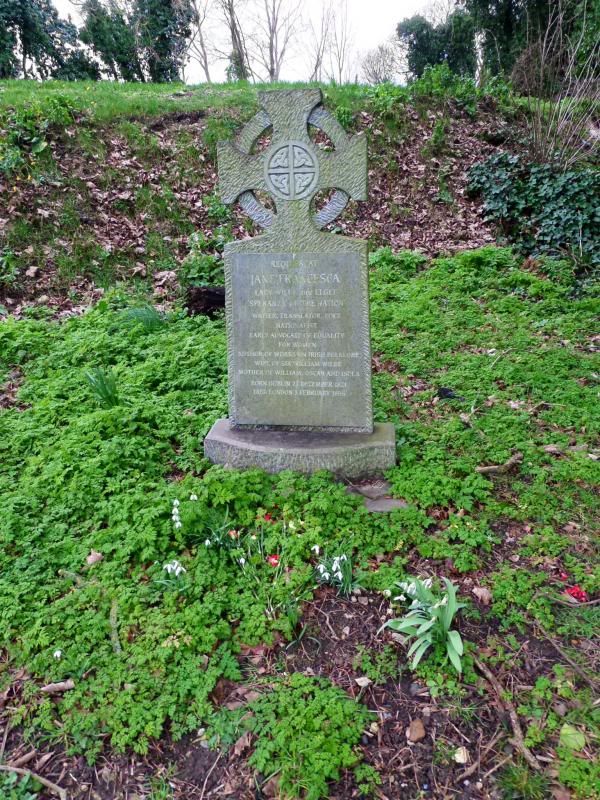
John Cam Hobhouse was the archetypical loyal friend in Byron's life, and sometimes in earlier biographies tends to suffer the fate John Watson does in certain mid 20th century Sherlock Holmes adaptions, i.e. being written as loyal but dim. Which is a gross injustice. One of the reasons for their lasting friendship was, after all, that Hobhouse did what Byron only temporarily flirted with and couldn't quite pull off, becoming an active Whig politician. The admiration and respect was mutual. Hobhouse made it into another age and thus got this very Victorian monument, courtesy of his daughter:
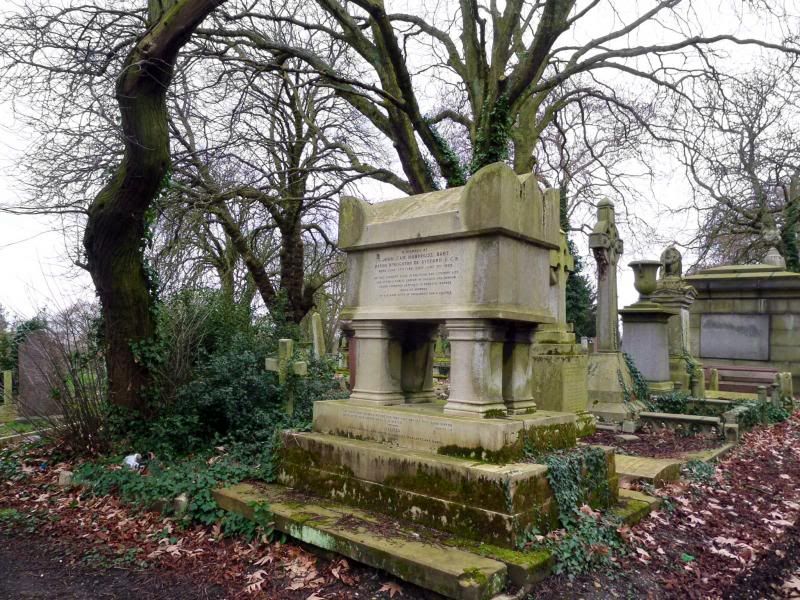
Kensal Green isn't as aesthetically stunning as the Western side of Highgate, but it does have its share of extravagant burial sites, like this one (not belonging to anyone I know):
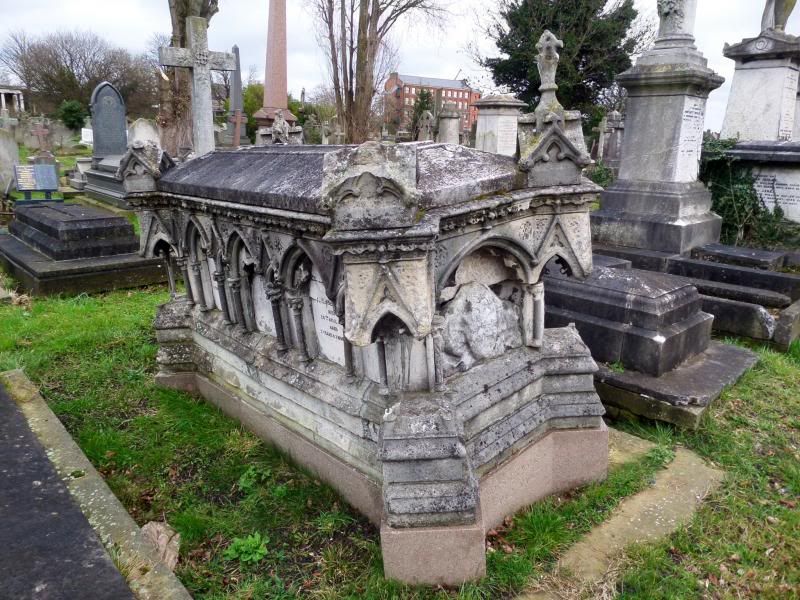
Or these, which are just behind Wilkie Collins' tomb, to which I'll get in a moment. But first, observe: methinks Wilkie C., creator of the "Sensation Novel", would have loved to be surrounded by this:
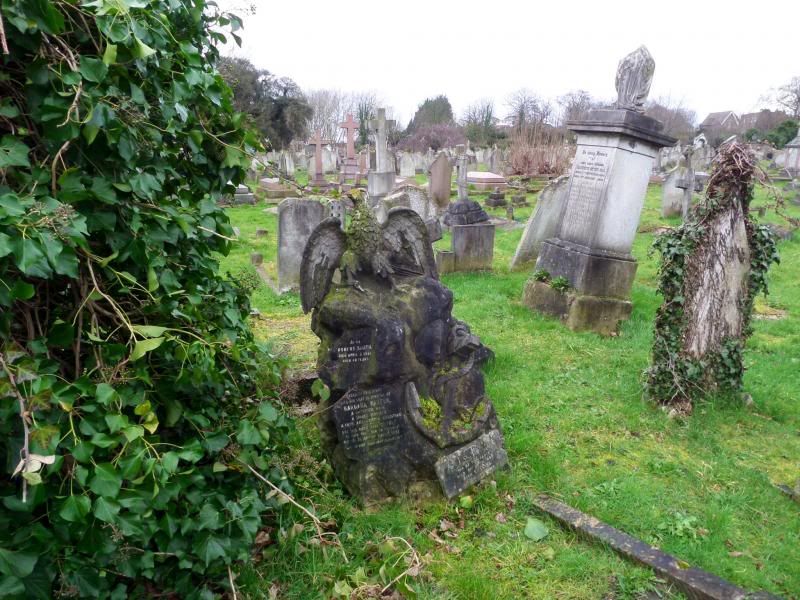
And here is his grave, where he's buried with one of the two women he lived with (simultanously, without being married to either), Caroline, supposedly the original "Woman in White":
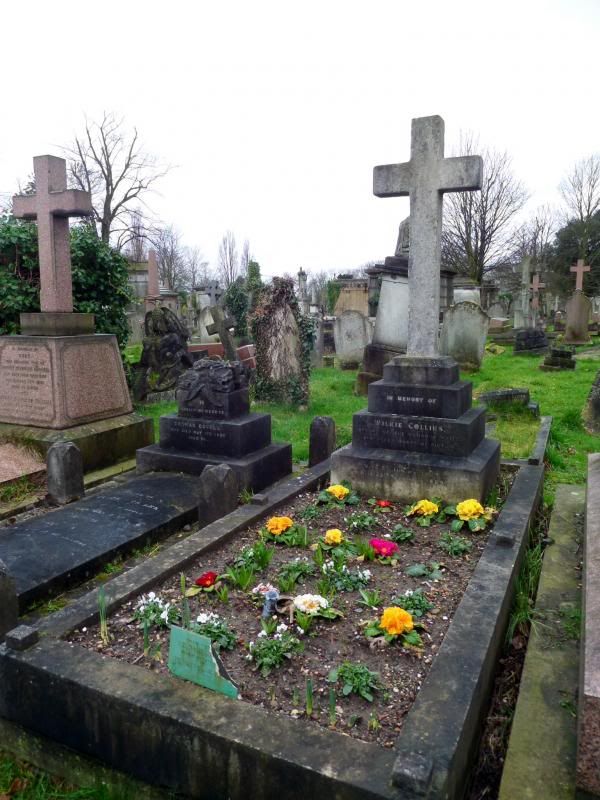
Note Wilkie and Caroline get flowers and apparantly someone who regularly gardens their grave.
For detailed background information on the Byron-Augusta-Annabella triangle which resulted in big scandal and Byron leaving England, I refer you to my review here. Augusta Leigh, Byron's sister, is buried not beneath a tombstone but in the catacombs below the Anglican Chapel, where you're not allowed to take pictures. Putting their dead in lead coffins (which were then put in wooden coffins) and these in catacombs was (cheaper) alternative, and due to not only Augusta's husband but several of her children being gambles, the Leighs were never well off. Otoh Annabella who survived practically everyone else in the Byron saga (she died in 1860), including her daughter Ada, is buried in marble here:
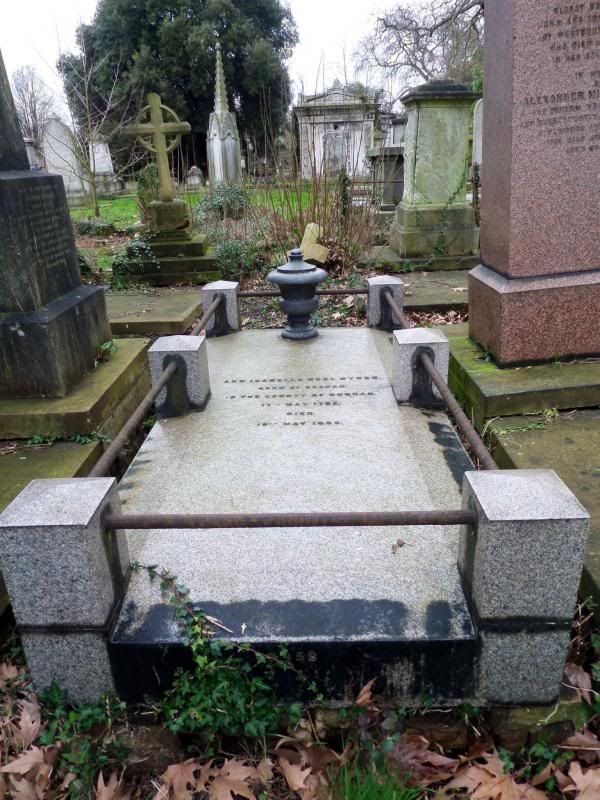
(Ada, who went on to become a computer pioneer and is most often referred to as Ada Lovelace, btw, is buried with her father in Nottinghamshire in the old family vault. This was her choice and a deliberate slap in the face re: her mother. If your mother used your own husband to spy on you and withheld morphine while you're dying of cancer and screaming with pain because suffering is good for the soul and might cleanse you from your sins, you might have done the same.)
And now for the second most famous Victorian writer of all time. Now his rival Dickens, who didn't want it (but had his will ignored), got Westminster Abbey. Thackeray got this:
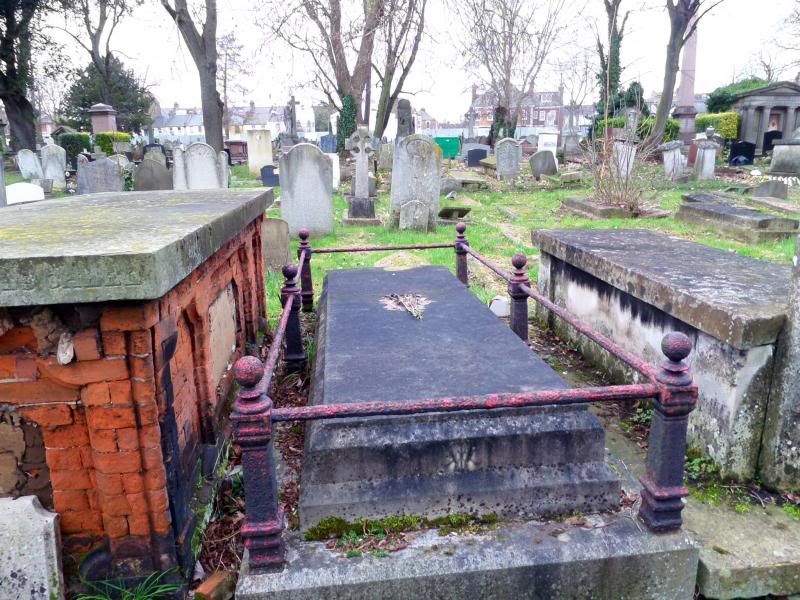
Seriously, guys, I'm not even a Thackeray fan (did like Vanity Fair, with some reservations), but what? Doesn't he have a society who takes care of such things? The only reason why I was even capable of identifying the grave (the name is illegible now) was because it's photographed in the map/guide book they give you at the entrance of the cemetery.
...then again, given their respective critical reputations, I must admit the fact Wilkie still has fans and Thackeray does provide a certain "hooray for the sensation novel!" amusement. :)
To end on a more cheerful note, here are the pelicans of St. James Park (then again, one of them sadly has been bereft of his wing feathers):
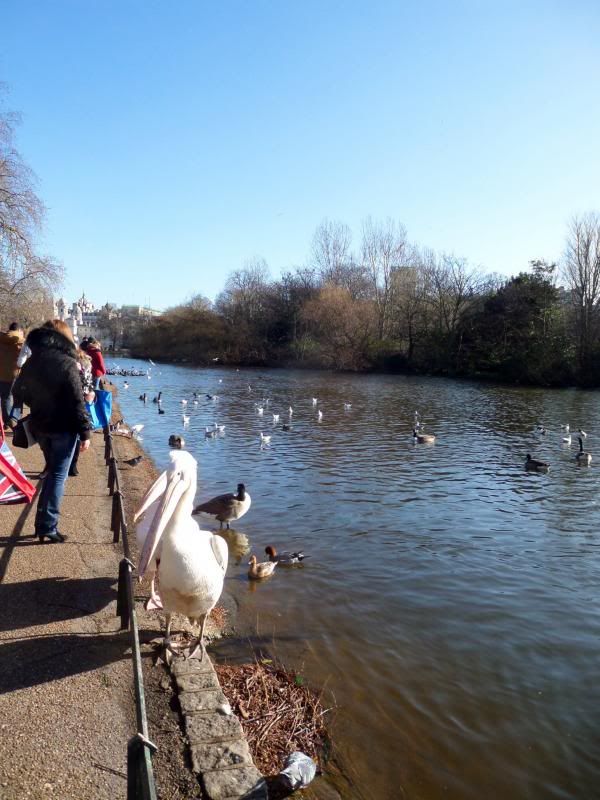
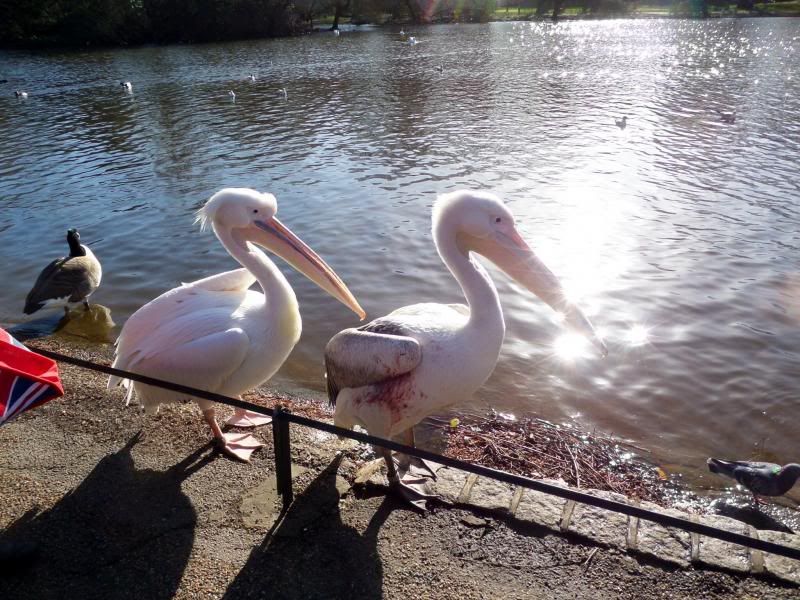
But these three are fine:
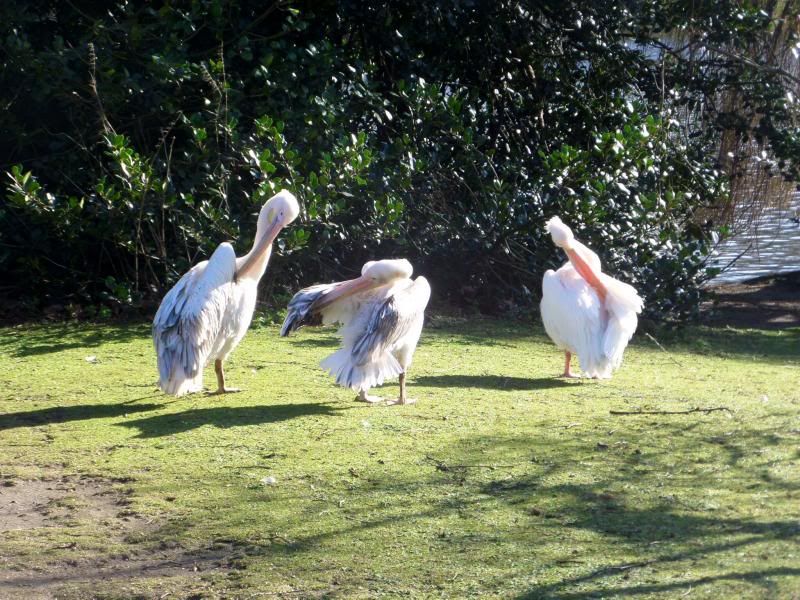

Why yes, I am a Restoration Dandy:



This entry was originally posted at http://selenak.dreamwidth.org/964706.html. Comment there or here, as you wish.
On the other hand, hitting the London theatres continues; on Monday I also met up with

kangeiko and saw A Taste of Honey by Shelagh Delaney at the National. Neither of us knew anything about the play other than the name of the author, the title and that it was now considered a modern classic. My main reason for wanting to see it was that Lesley Sharpe plays one of the two leading roles. Now that I've watched it, though, I am in awe that a play like this could be created and staged in 1958, by a female author, and so utterly unlike the simultanous plays of John Osborne & Co. In fact, depressingly it still stands out compared with much of today's theatre, tv and cinema output, many decades later. First of all, the main focus is on a complex mother-daughter relationship. Secondly, the daughter, Jo, has an affair with a black sailor, Jimmie, and later has a gay friend, Geoffrey, who moves in with her. The mother, Helen, had Jo when she was young and the two at times act more like bickering sisters than like mother and daughter, with Jo as the responsible one; Helen is also in and out of relationships which more or less provide her income. Inevitably, Jo, too, gets pregnant. And yet: Nobody committs suicide or beats each other up or gets murdered. No one is slut shamed. And not because anyone is living in an idyll or life is kind. The program had a line about the characters being "different types of survivors in a world that doesn't throw anyone lifebelts", and that's true, and yet it is not a cynical play. The characters and their relationships come across as three dimensional and true, and no one feels like a vehicle for the author's rant on issue X. Now I'm all the more frustrated Shelagh Delaney didn't go on to write many more plays (though she did write one more play and some radio and tv scripts, as a quick googling tells me). What a talent! Yes, some writers have only one perfect work in them - see also Harper Lee - but those are the exception; most, given the opportunity, can do more.
As for the production, I thought both Kate O'Flynn as Jo - who is on stage in most scenes and so really needs to be good - and Lesley Sharpe as Helen were fabulous, and so was their supporting cast. The staging and costumes went for the time the play was written in and set, i.e. late 50s, and yet it didn't feel "period" in the sense of feeling distanced; it never played into nostalgia, being too sharp and witty for that. In conclusion: if you're in London for the next two months, try and catch it!
Yesterday was no theatre day because I was invited to a wonderful friend of mine for dinner, a lovely old lady who is one of the most amazing people I've known, and who'll be 90 next year. She's originally from Munich where her father was a very respected lawyer. You may have seen his photo, because when the Third Reich arrived, her father made the mistake believing in justice and complained to the police about harrasment. In response, they made him run through Munich in his underwear with a sign around his neck saying "I am a Jewish pig and will never complain to the police again". (Last year at the anniversary of the so-called "Reichskristallnacht" the photo got reprinted in a lot of Munich-based media again.) Anyway, Bea's parents then got her out of the country via the Kindertransport to England, hence her ending up here. I met her over a decade ago and we've been in contact ever since; she's so full of life and charming and optimistic that you're moved and humbled by her very presence if it wasn't that she's far too animated and drawing response not to enjoy oneself just for the good company.
(I cried once anyway, years ago, because sometimes the awful horror of it all overwhelms you anew.)
Anyway, yesterday evening I visited her and her family, and we had a great evening. It included an anecdote about an encounter with the royals apropos a Holocaust museum/exhibition opening here in London, where Bea and other surviving children who came to England through the Kindertransport had been invited and were presented to the Queen and Prince Philipp. Said exhibition included a model of Auschwitz, with the huts all in white, according to Bea. Says Philipp, gesturing towards the Auschwitz model: "And where do you live now? Not there anymore, right?"
.....
Tuesday was good for hanging out with friends, though; lunch I spent with

kathyh at a pub which was an amazing relic of the turn of the (19th into 20th) century full of art deco. Originally we met at the Modern Tate and were planning to have lunch there, but it was too crowded, it being half term in Britain this week, which I hadn't known but which explained all the children I encountered. Generally speaking, I prefer the Tate Britain because of the Williams Turner and Blake represented there, but I did want to see the Richard Hamilton exhibition, which included his series of pictures called "Swingeing London" (sic, it's a pun) using the photo of Robert Fraser and Mick Jagger handcuffed to each other when arrested during the 1967 drug bust, and his design for the Beatles' White Album. (The cover, obviously, is just white, but the exhibition also had the original for the inside poster that came with the LP and was based on a collage of photographs culled from their archives. Today in the age of the cd (well, the age of Itunes, I guess,now), you can't make out individual photos,far too tiny, but in the big A3 size original where all the photos are in their original size, too, you can, and my inner Beatles obsessive was not a bit embarrassed to be able to identify many of them. (Both the original cover design and the original inside poster design were said to be on loan from a "private collection", which I guess means Paul McCartney.)
And now for the graves of Victorian writers (guess who still gets flowers and who doesn't?) and the sisters, wives and best buddies of Mr. Mad, Bad and Dangerous To Know himself, Lord Byron (those would be the Georgians I mentioned earlier. And because they are adorable, some of Sunday morning's pelicans, whose ancestors supposedly came to St. James Park with the Restoration and Charles II.
Jane Francesca, aka "Speranza" Wilde - "mother of Oscar, William and Isola", as it says on the tombstone - was a fervent Irish nationalist, a collector of fairy tales and early feminist; her salons in Dublin and later in London were famous (and open to newbies; George Bernard Shaw never forgot she was nice to him, invited and introduced him when he first came to London). She adored her oldest son, and died during his time in prison. Her younger son, Willie, is buried with her, as is Willie's wife; Oscar, of course, is buried at Pere Lachaise in Paris. This is her grave at Kensal Green:

John Cam Hobhouse was the archetypical loyal friend in Byron's life, and sometimes in earlier biographies tends to suffer the fate John Watson does in certain mid 20th century Sherlock Holmes adaptions, i.e. being written as loyal but dim. Which is a gross injustice. One of the reasons for their lasting friendship was, after all, that Hobhouse did what Byron only temporarily flirted with and couldn't quite pull off, becoming an active Whig politician. The admiration and respect was mutual. Hobhouse made it into another age and thus got this very Victorian monument, courtesy of his daughter:

Kensal Green isn't as aesthetically stunning as the Western side of Highgate, but it does have its share of extravagant burial sites, like this one (not belonging to anyone I know):

Or these, which are just behind Wilkie Collins' tomb, to which I'll get in a moment. But first, observe: methinks Wilkie C., creator of the "Sensation Novel", would have loved to be surrounded by this:

And here is his grave, where he's buried with one of the two women he lived with (simultanously, without being married to either), Caroline, supposedly the original "Woman in White":

Note Wilkie and Caroline get flowers and apparantly someone who regularly gardens their grave.
For detailed background information on the Byron-Augusta-Annabella triangle which resulted in big scandal and Byron leaving England, I refer you to my review here. Augusta Leigh, Byron's sister, is buried not beneath a tombstone but in the catacombs below the Anglican Chapel, where you're not allowed to take pictures. Putting their dead in lead coffins (which were then put in wooden coffins) and these in catacombs was (cheaper) alternative, and due to not only Augusta's husband but several of her children being gambles, the Leighs were never well off. Otoh Annabella who survived practically everyone else in the Byron saga (she died in 1860), including her daughter Ada, is buried in marble here:

(Ada, who went on to become a computer pioneer and is most often referred to as Ada Lovelace, btw, is buried with her father in Nottinghamshire in the old family vault. This was her choice and a deliberate slap in the face re: her mother. If your mother used your own husband to spy on you and withheld morphine while you're dying of cancer and screaming with pain because suffering is good for the soul and might cleanse you from your sins, you might have done the same.)
And now for the second most famous Victorian writer of all time. Now his rival Dickens, who didn't want it (but had his will ignored), got Westminster Abbey. Thackeray got this:

Seriously, guys, I'm not even a Thackeray fan (did like Vanity Fair, with some reservations), but what? Doesn't he have a society who takes care of such things? The only reason why I was even capable of identifying the grave (the name is illegible now) was because it's photographed in the map/guide book they give you at the entrance of the cemetery.
...then again, given their respective critical reputations, I must admit the fact Wilkie still has fans and Thackeray does provide a certain "hooray for the sensation novel!" amusement. :)
To end on a more cheerful note, here are the pelicans of St. James Park (then again, one of them sadly has been bereft of his wing feathers):


But these three are fine:


Why yes, I am a Restoration Dandy:



This entry was originally posted at http://selenak.dreamwidth.org/964706.html. Comment there or here, as you wish.